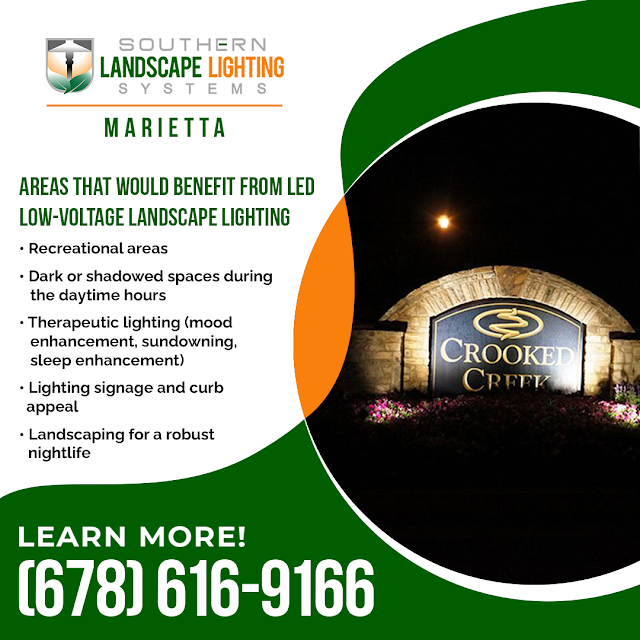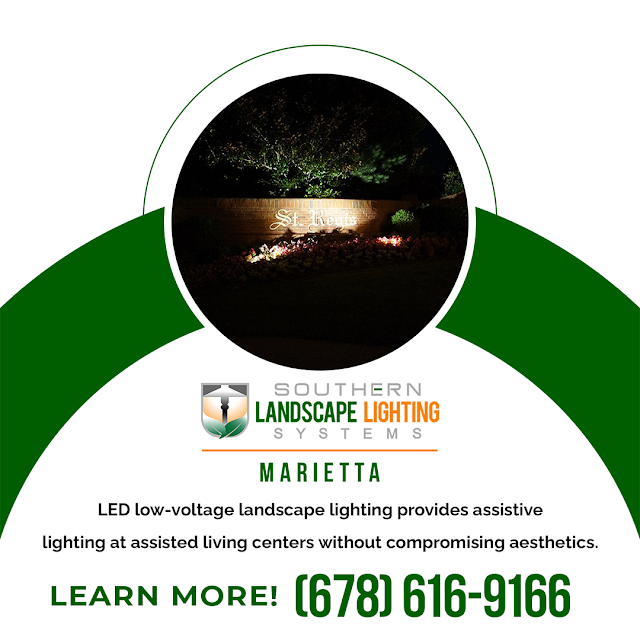The team at Southern Landscape Lighting Systems of Marietta designs and installs outdoor LED lighting systems for a wide variety of applications. One such application is the installation of landscape lighting to enhance the beauty and safety of the outdoor facilities at an assisted living community.
The 2020 census reports that there are approximately 55 million Americans over the age of 65. Every day in the US, 10,000 people celebrate this milestone in their lives. Continuing care retirement communities meet the growing needs of this aging demographic.

According to the National Institute of Health (NIH), “Continuing care retirement communities (CCRCs), also called life care communities, offer different levels of service in one location. Many of them offer independent housing (houses or apartments), assisted living, and skilled nursing care, all on one campus. Healthcare services and recreation programs are also provided. In a CCRC, where you live depends on the level of service you need. People who can no longer live independently move to the assisted living facility or sometimes receive home care in their independent living unit. If necessary, they can enter the CCRC’s nursing home. Assisted living is for people who need help with daily care but not as much help as a nursing home provides. Assisted living facilities range in size from as few as 25 residents to 120 or more. Typically, a few “levels of care” are offered, with residents paying more for higher levels of care.”
The NIH goes on to describe more aspects of assisted living: “Assisted living residents usually live in their own apartments or rooms and share common areas. They have access to many services, including up to three meals a day; assistance with personal care; help with medications, housekeeping, and laundry; 24-hour supervision, security, and on-site staff; and social and recreational activities. Exact arrangements vary from state to state.”
Georgia has almost 700 assisted living centers, and nearly half of these facilities are in the greater Atlanta area. Acworth, Alpharetta, and Marietta are dotted with numerous continuing-care retirement communities, many of which provide assisted living services. Nearly 13% of Marietta residents are over the age of 65.
Assistive lighting for assisted living
Many residents in continuing care and assisted living centers enjoy a high level of independent living and mobility. These elder care communities offer exercise and recreational venues ranging from hiking trails and walking tracks to paved walkways and sitting areas with benches. Each venue accommodates one or more levels of independence and mobility. LED low-voltage landscape lighting provides assistive lighting at assisted living centers without compromising aesthetics. In fact, landscape lighting not only expands safe access to venues after dark but also enhances aesthetic beauty.
Below are some practical applications for facility and grounds maintenance managers to consider when evaluating the safety, security, functionality, and aesthetics of the elder care facility.
Ramps and rails
Steps limit or prevent accessibility to residents in a wheelchair or using a walker. A knee or hip replacement can make climbing or descending steps risky. In place of steps, architects have incorporated gentle grades or constructed ramps. Eliminating steps does not forego the need to illuminate the sloped areas. Adequately bright path lighting assists the resident in discerning depth, which is necessary to prevent overbalance and a potential fall. Railings are very important on both upslopes and downslopes. On the upslope, the railing enables the resident to pull their way up the slope. On the downslope, the railing stabilizes the resident, preventing overbalance. A simple, well-lit bench at both the top and bottom of the incline adds a measure of safety as well as a nice aesthetic.
Steps and rest stops
Since a continuing care retirement center includes residents with a full range of mobility, some steps may be included in the landscape of the facility. These steps should be free of shadows, and glare should be kept to a minimum or eliminated altogether. Illuminated handrails provide an extra measure of security in case a resident loses their grip. A lighted bench for rest and recovery is important in areas where physical exertion may leave a resident in need of a brief rest.
Landscape lighting for the immobile
Once the sun goes down, mobility is restricted for many residents by choice or by physical limitations. Many continuing care residential communities (CCRCs) have made beautiful landscaping a top priority. Beautiful gardens, fabulous water features and statuary, meandering walkways, and magnificent trees festoon the landscape. This landscape can be experienced in all its glory after the sun sets with the help of a skilled landscape lighting artisan. Many residential retirement communities are on the outskirts of suburbs and are often visited by ample wildlife when darkness falls. Deer, rabbits, raccoons, skunks, and wild boar will amble through the gated neighborhoods, industrial parks, and even CCRCs. LED landscape lighting enables all residents, including the infirm, to enjoy the nocturnal antics of indigenous wildlife.
Other areas that would stand to benefit from LED low-voltage landscape lighting include:
- Recreational areas
- Dark or shadowed spaces during the daytime hours
- Therapeutic lighting (mood enhancement, sundowning, sleep enhancement)
- Lighting signage and curb appeal
- Landscaping for a robust nightlife
The metro Atlanta LED low-voltage lighting company offers an onsite, in-person consultation. Be sure to inquire about the onsite nighttime demonstration. A beautiful landscape deserves to be enjoyed, especially after sunset.

Contact Southern Landscape Lighting Systems for more information about landscape lighting installation. The Marietta office can be reached by calling (678) 616-9166 or by emailing [email protected].
